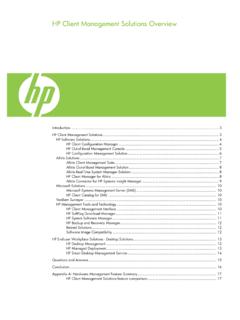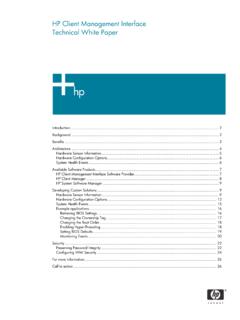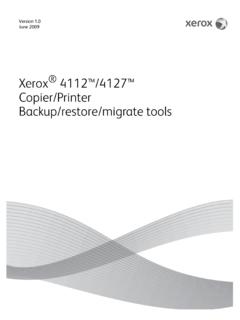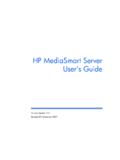Transcription of HP Softpaq Download Manager and HP System …
1 Executive Overview .. 2 Overview of HP SSM and HP Softpaq Download Manager .. 2 Use Case for SDM/SSM .. 2 How SSM and SDM work together .. 3 Setup and Usage Process Overview .. 4 General Requirements and Setup .. 4 HP Softpaq Download Manager .. 4 HP System Software Manager .. 4 Supported Client PCs and Softpaqs .. 4 Downloading and Installing HP SSM and SDM .. 4 Setting up and Using HP Softpaq Download Manager .. 4 Configuration Options .. 4 Downloading Softpaqs .. 6 Setting up HP SSM (Admin) .. 7 Setting up HP SSM (Clients) .. 7 Maintenance Process .. 8 Adding and Removing 8 Advanced usage of HP SDM and SSM .. 8 Running SSM from Removable Media .. 8 Updating the SSM DB and CVAs using Command Line .. 9 Other SSM Configuration Options .. 9 Multiple Filestores .. 9 Other HP Solutions .. 9 HP Softpaq Download Manager and HP System Software Manager A Powerful Combination Subtitle Executive Overview Keeping PCs in a business up to date with the latest SoftPaqs presents a number of problems, including time, bandwidth, and logistical issues.
2 HP offers two free tools, HP Softpaq Download Manager (SDM) and HP System Software Manager (SSM), which can be used in conjunction to help streamline the update process, reduce IT costs, and improve the total cost of ownership (TCO) for your HP computers. By using these tools, companies can automatically keep all of their HP computers up to date with the latest SoftPaqs (software packages for updates to drivers/BIOS and certain software for HP computers), instead of having to run each Softpaq individually on each computer, not knowing if the Softpaq actually needs to be installed. This document covers the following topics: Overview of HP SDM and HP SSM Setting up and using HP SDM and SSM Customizing usage of HP SDM and SSM Overview of HP SSM and HP Softpaq Download Manager HP Softpaq Download Manager (SDM) is a software tool designed to streamline the Softpaq Download process.
3 Instead of manually downloading each Softpaq , IT personnel can get all appropriate SoftPaqs for each of their computers all in one sitting. HP System Software Manager (SSM) is a free software tool designed to simplify deployment of SoftPaqs to HP computers. The SSM tool detects which updates apply to the System from the available SoftPaqs and installs them onto the System , so you do not have to worry about accidentally installing an older version. SSM accesses the SoftPaqs from the local network or local folder instead of downloading them from the internet, cutting down on update time and saving network bandwidth. For more details on either of these tools visit the following Web sites: SSM: SDM: Use Case for SDM/SSM Using HP SDM and SSM to manage software updates is ideal for: Small to medium business sizes (1-100) Updating a group of PCs outside normal IT maintenance Note that SSM will only update computers with SoftPaqs that are marked as SSM compliant.
4 How SSM and SDM work together The following image illustrates how SSM and SDM interact. Figure 1. How SSM and SDM work together Setup and Usage Process Overview 1. Download and install HP SDM. 2. Set up SDM configuration for the computer models you want to update. 3. Download desired SoftPaqs. 4. Run SSM in admin mode to prepare the Download directory for SSM usage. 5. Repeat steps 2 and 3 for any additional file shares you want to create and use. 6. Manually share the file share, if necessary. 7. Setup SSM on the client computers to run at predetermined times, or run SSM manually. General Requirements and Setup HP Softpaq Download Manager .Net Framework or later Broadband Internet Connection (Proxies that require authentication are currently not supported) 512MB RAM minimum, 1GB recommended Windows XP or Vista HP System Software Manager Computer to host a Windows-compatible file share Supported HP/HP Compaq computers attached to a network, running Windows XP or Vista Supported Client PCs and Softpaqs HP SDM and SSM are only supported for certain HP business products (desktops, notebooks, tablets, workstations, and blades).
5 Servers and consumer-level products are not supported by SDM and SSM. SDM will also indicate whether a Softpaq is SSM compliant. If the Softpaq is not marked as SSM compliant, SSM cannot be used to deploy that Softpaq . In addition, certain platforms and operating systems may not be supported under SDM and/or SSM. Consult the SDM and SSM documentation for details. Downloading and Installing HP SSM and SDM The latest versions of HP System Software Manager and Softpaq Download Manager are available from HP at and When you install SSM, no icon is placed in the Start menu for SSM; however, the program is available in Hewlett-Packard\SSM under the Program Files directory. HP SDM is displayed in Start > All Programs > HP > HP Softpaq Download Manager . Setting up and Using HP Softpaq Download Manager Configuration Options When HP SDM is run for the first time, a window is displayed that asks if you want to show only software for the computer it is running on.
6 Select the second option to display all supported models. Figure 2. SDM module selection Once loaded, the Configuration window should automatically display. Optionally, you can go to Tools > Configuration Options to bring up the Configuration window. If you do not see the menu option, you are running in This Computer mode. Switch SDM to show all products by clicking on the Show All Products button. For each of the tabs, set the following options: Download - Download Directory Set to a folder that you can share. This can be either a local folder or a mapped network drive/folder. This will be the location of your SSM File Store. - Download Structure Set to Separate Folders by Softpaq Names. This helps with the management of SoftPaqs. OS Filter - Select from the list the operating systems that are running on the network.
7 Note that not all operating systems listed are supported by SSM1. Language Filter - Select the language versions of the operating systems on your network. Columns - No options need to be set. 1 Although SSM supports Windows 2000 ( is the last supported version for Windows 2000), for the purposes of this document, Windows 2000 is NOT supported. Figure 3. Product Catalog Appearance Once the options are set, you can select the model(s) of the products you want to update. Note Once all of the selections have been made, you can save the configuration file for future use and backup purposes. This preserves the Download directory, Download structure, OS and language settings, and the products you selected. To save, go to File > Save Product Configuration. Downloading Softpaqs Click Find Available SoftPaqs to Download a list of available SoftPaqs for selected systems.
8 Only SoftPaqs marked as SSM-compliant are added to the SSM database. To help with the selection process, you can configure SDM to select all SSM-compliant SoftPaqs by clicking Select Softpaqs > Auto-Installable (SSM-Compliant). Click Show Latest SoftPaqs to set SDM to display only the latest version of each Softpaq if multiple versions are available. When only the latest SoftPaqs are displayed, you can click Show All SoftPaqs to display all SoftPaqs. Figure 4. Auto-selecting and Filtering Softpaqs Once the SoftPaqs are selected, click Download . Make sure the Download option is set to Download Only. Softpaq selection and internet connection speed determine how long the Download process may take, but please note that the process may take some time. Setting up HP SSM (Admin) This setup process should be run after the SoftPaqs have been downloaded.
9 To run and setup SSM in admin mode, perform the following steps: 1. Navigate to Hewlett-Packard\SSM in the Program Files directory (or Program Files (x86) if running 64-bit Windows), and then run 2. When prompted for the location of the file share, navigate to the SDM Download directory. Type the name you want to use for the file share, and then click Next. 3. If you are presented with a message about being missing, double-click on the specified text to copy the file to the file store, and then click Next until you reach client options. 4. Select Reboot client upon completion of upgrades, and then click Next. 5. Click Next until you reach the Build Database window. 6. Select Check for CVA file updates first. This causes SSM to update the specification file for each Softpaq , which may include bug fixes and expanded coverage.
10 7. Click Build Database, and wait for the build process to finish. 8. Click Finish to complete the process. 9. Copy to the root of the SDM Download directory. This allows easier execution of SSM from the network. The client PCs will need access to the file share containing the SoftPaqs for SSM to run properly on those computers. SSM will try to create the share automatically; however, this may not work (domain settings, share is located on another computer, etc.), so you may need to manually share and/or change the settings of the target folder. Setting up HP SSM (Clients) To run SSM in client mode, you only need to specify the location of the file share and any other desired command line switches as parameters. should be run from the root of the file share. The command recommended to run SSM is: <file store path>\.















